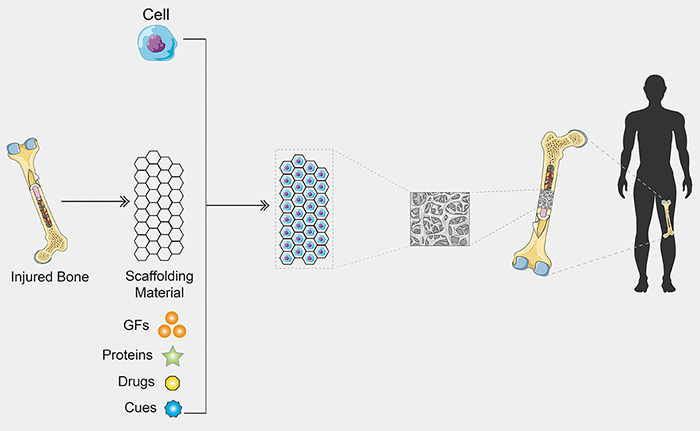The products from CD Bioparticles include specialized delivery techniques, tissue engineering scaffold design and modification, and cutting-edge technology platforms that can help you with:
The challenges you might meet:
- Lack a favorable cell growth environment for the investigation of tissue regeneration after damage or loss;
- insufficient research lab materials;
- Lack of temporary or long-term support structures that encourage the formation of new tissues with good biocompatibility in the research of healing or replacing damaged tissues;
- Animal testing is costly when developing and testing drugs.
- The field of regenerative medicine is in need of more research and development materials.

Tissue Engineering Scaffold Key features:
Tissue Engineering Scaffold Key benefits:
- Biomimicry: It is possible to create tissue engineering scaffolds that resemble the extracellular matrix (ECM) found naturally in the body. Scaffolds can provide an environment that closely resembles the native tissue, encouraging cell adhesion, proliferation, and differentiation by imitating the structure and makeup of the ECM.
- Cell Support and Organization: Scaffolds offer a three-dimensional (3D) structure that enables regulated cell growth and organization. They give the cells physical support, assisting them in preserving their integrity and shape as the tissue grows. Scaffolds also direct tissue and cell development in developing tissues.
- Biodegradability: Many scaffolds used in tissue engineering are made to disintegrate naturally over time and be replaced by freshly generated tissue. The requirement for subsequent surgical procedures to remove the scaffold after the tissue has recovered is eliminated with biodegradable scaffolds. This characteristic enables the development of transient scaffolds that aid in tissue growth throughout the healing process and eventually degrade as the tissue matures.
- Customization and Tailoring: Customized and adapted scaffolds for tissue engineering are available for various applications and tissues. To meet the unique needs of the target tissue or organ, they can be manufactured in a variety of sizes, shapes, and porosity levels. Additionally, scaffolds can be altered to include bioactive compounds, growth factors, or medications, which can speed up the healing process and improve tissue regeneration.
- Disease Modeling and Drug Testing: Scaffolds can be used to create in vitro models that mimic diseased tissues or organs. These models enable researchers to study disease progression, test potential therapies, and evaluate the safety and efficacy of drugs in a controlled environment. Tissue engineering scaffolds thus provide a valuable tool for drug discovery and personalized medicine.
- Transplantation and Organ Replacement: Tissue engineering scaffolds hold great potential for creating functional replacement organs or tissue grafts for transplantation. By combining scaffolds with appropriate cells and growth factors, scientists aim to develop fully functional organs that can overcome the shortage of donor organs and minimize the risk of rejection.
Tissue Engineering Scaffold Application candidates:
- Regenerative Medicine: By encouraging the regeneration of damaged or diseased tissues, tissue engineering scaffolds play a significant role in regenerative medicine. Scaffolds, for instance, can be utilized to restore bone, cartilage, skin, blood vessels, and organs like the liver or heart that have been injured.
- Drug Development and Testing: In vitro models of human tissues can be produced more precisely by using scaffolds in drug development and testing. Researchers can analyze the effects of medications and assess their toxicity, efficacy, and safety before moving forward with animal or human trials by cultivating cells on scaffolds that replicate the natural tissue architecture.
- Disease Modeling: The development of disease models that closely resemble human tissues is made possible by tissue engineering scaffolds, giving researchers useful resources for examining the causes and progression of numerous diseases. These models can be employed to research disease processes, evaluate prospective treatments, and create personalized medicine strategies.
- Organ Transplantation: Scaffolds hold promise in the field of organ transplantation by providing a platform for growing functional organs in the lab. By seeding cells onto a scaffold, researchers aim to create fully functional organs that can be transplanted into patients, potentially addressing the shortage of donor organs and reducing the risk of rejection.
- Cosmetic and Reconstructive Surgery: Tissue engineering scaffolds have applications in cosmetic and reconstructive surgery. They can be used to promote tissue regeneration and support the growth of new skin, bone, or cartilage in patients with congenital defects, traumatic injuries, or those requiring breast reconstruction after mastectomy.
- Dental and Orthopedic Applications: Scaffolds are employed in dental and orthopedic applications for bone and cartilage regeneration. They can be used to repair bone defects, enhance bone fusion during spinal surgeries, and aid in the regeneration of damaged cartilage in joints.
